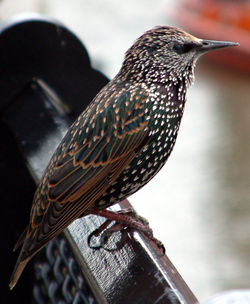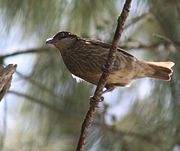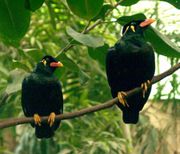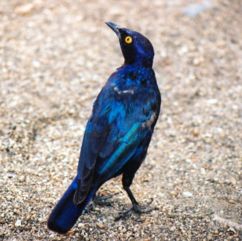Starling
2008/9 Schools Wikipedia Selection. Related subjects: Birds
| Starlings | ||||||||||||
|---|---|---|---|---|---|---|---|---|---|---|---|---|
 European Starling, Sturnus vulgaris
|
||||||||||||
| Scientific classification | ||||||||||||
|
||||||||||||
| Genera | ||||||||||||
|
Nearly 30, see text. |
Starlings are small to medium-sized passerine birds in the family Sturnidae. The name "Sturnidae" comes from the Latin word for Starling, sturnus. Starlings occur naturally in the Old World, from Europe, Asia and Africa, to northern Australia and the islands of the tropical Pacific. Several European and Asian species have been introduced to these areas as well as North America, Hawaii and New Zealand.
Starlings have strong feet, their flight is strong and direct, and they are very gregarious. Their preferred habitat is fairly open country, and they eat insects and fruit. Several species live around human habitation, and are effectively omnivores. Many species search for food by opening the bill after probing it into dense vegetation; this behaviour is called "open-bill probing" or is referred to by the German word "zirkeln" (pronounced [ˈtsɪʁkl̩n]).
Plumage is typically dark with a metallic sheen. Most species nest in holes, laying blue or white eggs.
Many Asian species, particularly the larger ones, are called mynas, and many African species are known as glossy starlings because of their iridescent plumage.
The shortest-bodied species is Kenrick's Starling (Poeoptera kenricki), at 15 centimetres (6 in), but the lightest-weight species is Abbott's Starling (Poeoptera femoralis), at 34 grams (1.2 oz). The largest starlings are the mynas of the genus Mino, especially the Yellow-faced (Mino dumontii) and Long-tailed Mynas (Mino kreffti). These mynas can exceed 30 centimetres (1 ft) and weigh over 225 grams (8 oz).
Starlings have diverse and complex vocalizations, and have been known to imbed sounds from their surroundings into their own calls, including car alarms, and human speech patterns. The birds can recognize particular individuals by their calls, and are currently the subject of research into the evolution of human language.
Systematics
The starlings belong to the superfamily Muscicapoidea, together with thrushes, flycatchers and chats, as well as dippers which are quite distant and Mimidae (thrashers and mockingbirds). The latter are apparently the Sturnidae's closest living relatives, replace them in the Americas, and have a rather similar but more solitary lifestyle. They are morphologically quite similar too - a partly albinistic specimen of a mimid, mislabelled as to suggest an Old World origin, was for many decades believed to represent an extinct starling (see Rodrigues Starling for details).
The oxpeckers are sometimes placed here as a subfamily, but the weight of evidence has shifted towards granting them full family status as a more basal member of the Sturnidae-Mimidae group, derived from an early expansion into Africa.
Usually the starlings are considered a family, as is done here. Sibley & Monroe (1990) included the mimids in the family and demoted the starlings to tribe rank, as Sturnini. This treatment was used by Zuccon et al. (2006). However, the grouping of Sibley & Monroe (besides leaving the subfamily rank vacant) is overly coarse due to methodological drawbacks of their DNA-DNA hybridization technique and most of their proposed revisions of taxonomic rank have not been accepted (see for example Ciconiiformes). The all-inclusive Sturnidae grouping is all but noninformative as regards biogeography, and obscures the evolutionary distinctness of the three lineages. Establishing a valid name for the clade consisting of Sibley/Monroe's "pan-Sturnidae" would nonetheless be desirable to contrast them with the other major lineages of Muscicapoidea.
Starlings probably originated in the general area of the East Asia, perhaps towards the southwestern Pacific, as evidenced by the number of plesiomorphic lineages to occur there. Expansion into Africa appears to have occurred later, as most derived forms are found there. An alternative scenario would be African origin for the entire "sturnoid" (as per Zuccon et al. 2006) group, with the oxpeckers representing an ancient relict and the mimids arriving in South America. This is contradicted by the North American distribution of the most basal Mimidae.(Cibois & Cracraft 2004, Zuccon et al. 2006)
As the fossil record is limited to quite Recent forms, the proposed Early Miocene (about 25-20 mya) divergence dates for the "sturnoids" lineages must be considered extremely tentative. Given the overall evidence for origin of most Passeri families in the first half of the Miocene, it appears to be not too far off the mark however.(Zuccon et al. 2006)
Recent studies (Cibois & Cracraft 2004, Zuccon et al. 2006) identified two major clades of this family, corresponding to the generally drab, often striped, largish "atypical mynas" and other mainly Asian-Pacific lineages, and the often smaller, sometimes highly apomorphic taxa which are most common in Africa and the Palearctic, usually have metallic coloration, and in a number of species also bright carotinoid plumage colors on the underside. Inside this latter group, there is a clade consisting of species which, again, are usually not too brightly-colored, and which consists of the "typical" myna- Sturnus assemblage.
Interestingly, the Philippine creepers, a single genus of 3 species of treecreeper-like birds appear to be highly apomorphic members of the more initial radiation of the Sturnidae (Zuccon et al. 2006). While this may seem odd ad first glance, their placement has always been contentious. In addition, biogeography virtually rules out a close relationship of Philippine creepers and treecreepers, as neither the latter nor their close relatives seem have ever reached the Wallacea, let alone the Philippines. Nonetheless, their inclusion in the Sturnidae is not entirely final and eventually they may remain a separate family.
Genus sequence follows traditional treatments. This is apparently not entirely correct, with Scissirostrum closer to Aplonis than to Gracula for example, and Acridotheres among the most advanced genera. Too few taxa have already been studied as regards their relationships however, and thus a change in sequence has to wait.
The upcoming review by Lovette & Rubenstein (in press) promises to resolve most uncertainties (though not the most pressing question: how Sturnus will be split up). Until it has been published, the following list should be considered preliminary.
Oriental-Australasian clade
- Genus Rhabdornis – Philippine creepers (3 species; placement here requires confirmation)
- Genus Aplonis – Pacific starlings (c.20 living species, 4-5 recently extinct)
- Genus Mino
- Yellow-faced Myna, Mino dumontii
- Golden Myna, Mino anais
- Long-tailed Myna, Mino kreffti
- Genus Basilornis
- Sulawesi Myna, Basilornis celebensis
- Helmeted Myna, Basilornis galeatus
- Long-crested Myna, Basilornis corythaix
- Apo Myna, Basilornis mirandus
- Genus Sarcops
- Coleto, Sarcops calvus
- Genus Streptocitta
- White-necked Myna, Streptocitta albicollis
- Bare-eyed Myna, Streptocitta albertinae
- Genus Enodes
- Fiery-browed Myna, Enodes erythrophris
- Genus Scissirostrum
- Finch-billed Myna, Scissirostrum dubium
- Genus Ampeliceps – Golden-crested Myna
- Genus Gracula – hill mynas (5 species)
Afrotropical-Palearctic clade
- Genus Acridotheres – typical mynas (8 species)
- Genus Leucopsar – Bali Starling
- Genus Sturnia (often included in Sturnus)
- Daurian Starling, Sturnia sturnina
- Chestnut-cheeked Starling, Sturnia philippensis
- White-shouldered Starling, Sturnia sinensis
- White-headed Starling, Sturnia erythropygia
- Genus Sturnus – typical starlings (about 12 species; includes probably valid genera Gracupica, Pastor and Temenuchus; but highly paraphyletic)
- Genus Creatophora – Wattled Starling
- Genus Notopholia (sometimes placed in Lamprotornis)
- Black-bellied Glossy-starling, Notopholia corrusca
- Genus Coccycolius – Iris Glossy-starling or Emerald Starling (sometimes placed in Lamprotornis)
- Genus Lamprotornis – typical glossy-starlings (20 species; monophyly requires confirmation)
- Superb Starling, Lamprotornis superbus
- Genus Cinnyricinclus
- Violet-backed Starling, Cinnyricinclus leucogaster
- Genus Poeoptera (formerly Pholia, sometimes included in Cinnyricinclus)
- Sharpe's Starling, Poeoptera sharpii
- Abbott's Starling, Poeoptera femoralis
- Genus Saroglossa (possibly paraphyletic)
- Spot-winged Starling, Saroglossa spiloptera
- Madagascar Starling, Saroglossa aurata
- Genus Spreo (paraphyletic with Lamprotornis and might be included there)
- African Pied Starling, Spreo bicolor
- Fischer's Starling, Spreo fischeri
- White-crowned Starling, Spreo albicapillus
- Genus Compsarus
- Golden-breasted Starling, Compsarus regius (sometimes placed in Lamprotornis)
- Ashy Starling, Compsarus unicolor (sometimes placed in Spreo)
- Genus Onychognathus
- Red-winged Starling, Onychognathus morio
- Slender-billed Starling, Onychognathus tenuirostris
- Chestnut-winged Starling, Onychognathus fulgidus
- Waller's Starling, Onychognathus walleri
- Somali Starling, Onychognathus blythii
- Socotra Starling, Onychognathus frater
- Tristram's Starling, Onychognathus tristramii
- Pale-winged Starling, Onychognathus nabouroup
- Bristle-crowned Starling, Onychognathus salvadorii
- White-billed Starling, Onychognathus albirostris
- Neumann's Starling, Onychognathus neumanni
- Genus Poeoptera
- Narrow-tailed Starling, Poeoptera lugubris
- Stuhlmann's Starling, Poeoptera stuhlmanni
- Kenrick's Starling, Poeoptera kenricki
- Genus Grafisia
- White-collared Starling, Grafisia torquata
- Genus Speculipastor – Magpie Starling
- Genus Neocichla
- Babbling Starling, Neocichla gutturalis
Unresolved
The extinct Mascarene starlings are of uncertain relationships. Only one species is known from specimens taken while the bird was still extant; the other remains only known from subfossil bones and apparently one early traveller's description. The supposed "Leguat's Starling" ("Necropsar leguati") was eventually determined to be a mislabeled albino specimen of the Martinique Trembler ( Cinclocerthia gutturalis), a mimid.
As the avifauna of the Mascarenes is predominantly of Indian origin though as old as to be highly distinct, it is not clear to which clade these starlings belong - or even if they are indeed starlings, as the Réunion Starling at least was highly aberrant and there have always been lingering doubts about whether they are correctly placed here.
- Genus Fregilupus – Réunion Starling (extinct, 1850s)
- Genus Necropsar – Rodrigues Starling (extinct, late 18th century?)


